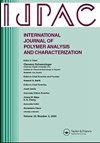热处理对掺杂 ZrO2 纳米粒子的聚丙烯的电荷状态、热物理性能和机械性能的影响
IF 1.6
4区 工程技术
Q4 POLYMER SCIENCE
International Journal of Polymer Analysis and Characterization
Pub Date : 2024-10-02
DOI:10.1080/1023666X.2024.2387605
引用次数: 0
摘要
掺杂纳米氧化锆的聚丙烯的电荷状态、热物理性能和机械性能及其在 60 ℃、100 ℃ 和 140 ℃ 热处理过程中的变化...本文章由计算机程序翻译,如有差异,请以英文原文为准。
Effect of heat treatment on charge states, thermophysical and mechanical properties of polypropylene doped with ZrO2 nanoparticles
Charge states, thermophysical and mechanical properties of polypropylene doped with zirconium oxide nanoparticles, and their changes during heat treatment at temperatures 60 °C, 100 °C, and 140 °C are studied. The methods used are thermal stimulated depolarization (TSD), scanning differential calorimetry (SDC), and mechanical life assessment. It is shown that with an increase in the concentration of the filler, the intensity of the TSD peaks increases up to 3 vol.%. A further increase in concentration leads to a decrease in the intensity of the peaks. The activation energy of charge release from traps, temperature of maximum of the peaks, and the magnitude of the accumulated charge in the traps have also maximal value at nanoparticle concentration of 3 vol.%. The study of charge characteristics of the nanocomposite with concentration of 3 vol.% after heat treatment shows that the intensity of TSD peaks, the temperature of peak maxima, and the activation energy of charge release increase with increasing pretreatment temperature. The magnitude of the charge accumulated in traps has a maximal value at treatment temperature of 140 °C owing to the increase in the number of traps. The melting point of the composite is 149.38 °C and shifts to 146.88 °C after heat treatment at 140 °C. It indicates that the high temperature of heat treatment leads to partial destruction of polymer chains, leading to a decrease in the critical melting temperature. The mechanical durability of PP + 3%ZrO2 nanocomposite decreases with increase in pretreatment temperature.
求助全文
通过发布文献求助,成功后即可免费获取论文全文。
去求助
来源期刊
CiteScore
3.50
自引率
5.30%
发文量
37
审稿时长
1.6 months
期刊介绍:
The scope of the journal is to publish original contributions and reviews on studies, methodologies, instrumentation, and applications involving the analysis and characterization of polymers and polymeric-based materials, including synthetic polymers, blends, composites, fibers, coatings, supramolecular structures, polysaccharides, and biopolymers. The Journal will accept papers and review articles on the following topics and research areas involving fundamental and applied studies of polymer analysis and characterization:
Characterization and analysis of new and existing polymers and polymeric-based materials.
Design and evaluation of analytical instrumentation and physical testing equipment.
Determination of molecular weight, size, conformation, branching, cross-linking, chemical structure, and sequence distribution.
Using separation, spectroscopic, and scattering techniques.
Surface characterization of polymeric materials.
Measurement of solution and bulk properties and behavior of polymers.
Studies involving structure-property-processing relationships, and polymer aging.
Analysis of oligomeric materials.
Analysis of polymer additives and decomposition products.

 求助内容:
求助内容: 应助结果提醒方式:
应助结果提醒方式:


